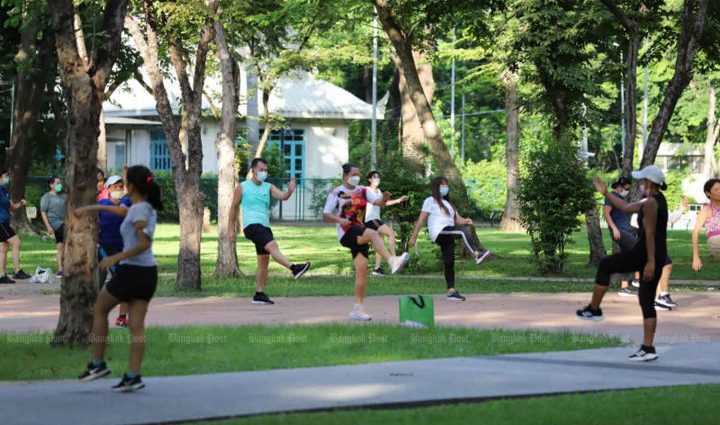
Fitness fanatics have been warned that getting their daily dose of training is about to become even more of a challenge and a health risk, with experts predicting a sharp rise in levels of PM2.5 toxic dust.
According to the Pollution Control Department’s Sunday press release, the Particulate Matter 2.5 (PM2.5) level in Bangkok and its surroundings reached an unhealthy level from Feb 1-3, but the situation was expected to improve from Monday due to strong winds from the South.
Although PM2.5 levels are up and down, they remain in an unsafe range; the toxic dust continues to plague the air of Thailand’s capital at an unhealthy level, especially for the respiratory-sensitive group, according to the Division of Air Quality Data under the Pollution Control Department’s report. The risk is expected to remain for the second week of this month.
Despite the dust’s continued harm, many outdoor exercisers persist in training in public parks, “the majority without a mask or any dust protection”, said Charoen Kitwattana, a 54-year-old gardener at Chatuchak Park.
“I haven’t seen a difference in the number of exercisers at the [Chatuchak] park since the start of February,” he said.
Exercisers do not seem to be overly concerned about the dust or related risks because it’s not visible in the early morning when most people go jogging there, he noted.
Speaking with regular exercisers around the area, Mr Charoen discovered most are uncomfortable wearing a mask while running because it reduces their performance and makes it harder to breathe.
The practice of not wearing masks during exercise is consistent with the announcement made by Dr Suwanchai Wattanayingcharoenchai, director-general of the Department of Health, on Jan 22, when the dust crisis was predicted.
“Wearing any type of mask while exercising should be avoided because it causes the body to breathe harder and faster, forcing the cardiovascular system to work harder, which could be harmful,” Dr Suwanchai said.
When the dust becomes dangerously elevated, it is best to skip exercising outdoors because the harmful dust may enter the respiratory system, bloodstream, and organs throughout the body, he added.
However, some people feel safer wearing a mask when working out outdoors, such as Pisitsan Nualanong, 24, who trains in Chatuchak Park and Kasetsart University’s 60th Anniversary Garden on a daily basis.
“I wear a mask while exercising to protect myself from dust, and I see it as another way to train my body,” he said.
While he is concerned about the level of PM2.5, indoor gyms don’t offer a conducive environment for exercise, he said, prompting him to venture outdoors.
Sasiporn Srisuwan, 67, a daily brisk-walker at Chatuchak Park, is similarly unconcerned about PM2.5 because “I think wearing a mask is sufficient,” she says.
Ms Sasiporn claims she does not feel uncomfortable or struggle to breathe while walking masked, as she got used to it during Covid-19. “The dust problem is always there. We must adapt and live with it,” she said.
When asked how the park deals with PM2.5, she said it sprays water daily to tamp down the dust.
While some people wear masks to protect themselves during exercising, others, such as Siwakorn Sathiannukun, a daily jogger at Sports Authority of Thailand’s Football Stadium near Hua Mak, say that when the PM2.5 level gets too high, “exercising indoors is a good alternative”.
“I find exercising outside more refreshing,” the 30-year-old said. “But when I feel I can’t handle the dust anymore, I go inside.”
He said the stadium appears to have done little to protect exercisers from the rising dust levels.
Meanwhile, Thai national football team and Chiang Rai United FC doctor, Ekkaphob Phianpeset, posted on his Facebook page on Feb 1 that outdoor exercise is still “possible”, but it “should not be too strenuous”.
He said the effect of PM 2.5 is dose-dependent, so limiting the duration and intensity of exercise will reduce the amount of dust entering the body.
“In areas with 200 micrograms per cubic metre of air, it is safe to walk for 30 minutes,” Dr Ekkaphob explained.
“In areas with 160 microgrammes or less of PM2.5, it is safe to run lightly or ride a bicycle for 30 minutes, keeping the heart rate around zone 2-3 [115-132 beats per minute],” he added.
“If you exercise harder than this, it will start to have an effect on your health,” Dr Ekkaphob warned.

